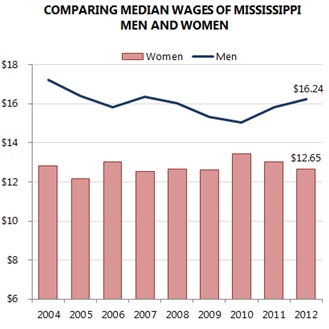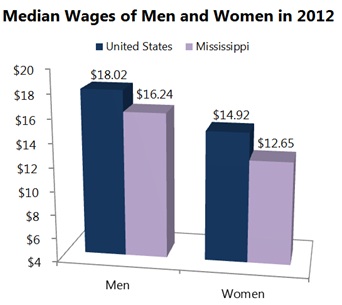Is The Gap Between Men’s and Women’s Wages Getting Larger?
May 8th, 2013
It has now been more than five years since Mississippi and the nation entered the 2007 recession. Across the country and in our state, men’s wages fell substantially from the mid-2000s to a low in 2010 (see chart). In contrast, women’s wages did not take the same dip as men’s, and in Mississippi estimates show that the median wage for women peaked in 2010. The combination of trends made it seem as though the gender wage gap was narrowing at the end of the last decade. In 2010, the median wage for women equaled 89% of the median wage for men.

However, wage data from 2011 and 2012 raises questions about whether there was a permanent narrowing of the gap, or a temporary effect from the economic constraints of the great recession. After adjusting for inflation, men’s wages are on the increase over the last two years, while women’s have fallen. In 2012, women’s wages equaled 78% of men’s – a lower percentage than 10 years before in 2002. In the U.S., women’s median wages were 82% of men’s in 2012.
For both genders the 2000s showed much slower wage progression than in the 1990s.
How do workers in Mississippi stack up against workers nationally?
In 2012, the median wage for Mississippi’s women ranked 48th among 50 states while the median wage for men ranked 42nd. Women’s wages fall behind Louisiana and Montana, and are $2.30 below the national median. Men’s wages in the state are $1.80 below men’s wages nationally (see chart).
These wage trends suggest that efforts to narrow the separation between men’s and women’s wages are still needed in Mississippi and nationally. Women make up close to half of our state’s labor force and a persistent difference in wages by gender has broad implications for families and the economic security of women.
Up Next: We’ll compare wages between different demographics in Mississippi and the South.
Sarah Welker, Senior Policy Analyst
Source: Economic Policy Institute analysis of Current Population Survey data. Adjusted for inflation to 2012 dollars using CPI.






